Simulating Block-Level Urban Expansion for National Wide Cities
Abstract
:1. Introduction
2. Literature Review
3. Data
3.1. Administrative Boundaries of Chinese Cities
3.2. Urban Land Area in 2007 and 2012
3.3. The Ordnance Survey Roads and Points of Interest (POIs) in 2011
3.4. Other Data
4. The MVB-CA Model
4.1. The Model Framework
4.2. The Macro Module
4.3. The Block Generation Module
4.4. The Vector CA Module
4.5. Model Computation Load
4.6. Model Examination
5. Results
5.1. The Blocks of All Chinese Cities in 2012
5.2. Model Calibration for the Vector CA Module
5.3. Simulation Results of the Vector CA Module
6. Discussion
6.1. The Model Evaluation from Online Feedback
6.2. Potential Biases and Next Steps
6.3. Potential Applications
7. Concluding Remarks
Acknowledgments
Author Contributions
Conflicts of Interest
References
- Stevens, D.; Dragićević, S. A GIS-based irregular cellular automata model of land-use change. Environ. Plan. B 2007, 34, 708–724. [Google Scholar] [CrossRef]
- Porta, J.; Parapar, J.; Doallo, R.; Rivera, F.F.; Santé, I.; Crecente, R. High performance genetic algorithm for land use planning. Comput. Environ. Urban Syst. 2013, 37, 45–58. [Google Scholar] [CrossRef]
- Montgomery, M.R. The urban transformation of the developing world. Science 2008, 319, 761–764. [Google Scholar] [CrossRef] [PubMed]
- Liu, Z.; He, C.; Zhang, Q.; Huang, Q.; Yang, Y. Extracting the dynamics of urban expansion in China using DMSP-OLS nighttime light data from 1992 to 2008. Landsc. Urban Plan. 2012, 106, 62–72. [Google Scholar] [CrossRef]
- Guan, W.; Wu, K.; Carnes, F. Modelling spatiotemporal pattern of agriculture feasible land in China. T. GIS 2016, 20, 426–447. [Google Scholar] [CrossRef]
- Liu, J.; Diamond, J. China’s environment in a globalizing world. Nature 2005, 435, 1179–1186. [Google Scholar] [CrossRef] [PubMed]
- Wu, K.; Long, Y.; Mao, Q.; Liu, X. Mushrooming Jiedaos, growing cities: An alternative perspective on urbanizing China. Environ. Plan. A 2015, 47, 1–2. [Google Scholar] [CrossRef]
- Long, Y.; Shen, Z.; Mao, Q. Retrieving spatial policy parameters from an alternative plan using constrained cellular automata and regionalized sensitivity analysis. Environ. Plan. B 2012, 39, 586–604. [Google Scholar] [CrossRef]
- Seto, K.C.; Woodcock, C.E.; Song, X.; Huang, X.; Lu, J.; Kaufmann, R.K. Monitoring land-use change in the Pearl River Delta using Landsat TM. Int. J. Remote Sens. 2002, 23, 1985–2004. [Google Scholar] [CrossRef]
- Tian, G.J.; Liu, J.Y.; Xie, Y.C.; Yang, Z.F.; Zhuang, D.F.; Niu, Z. Analysis of spatio-temporal dynamic pattern and driving forces of urban land in China in 1990s using TM images and GIS. Cities 2005, 22, 400–410. [Google Scholar] [CrossRef]
- Liu, J.Y.; Zhang, Z.X.; Xu, X.; Kuang, W.; Zhou, W.C.; Zhang, S.W.; Li, R.D.; Yan, C.Z.; Yu, D.S.; Wu, S.X.; et al. Spatial patterns and driving forces of land use change in China during the early 21st century. J. Geogr. Sci. 2010, 20, 483–494. [Google Scholar] [CrossRef]
- Kuang, W.H. Spatio-temporal Patterns of Intra-urban Land Use Change in Beijing, China Between 1984 and 2008. Chin. Geogr. Sci. 2012, 22, 210–220. [Google Scholar] [CrossRef]
- Seto, K.C.; Kaufmann, R.K. Modeling the driver of urban land use change in the Pearl River Delta, China: Integrating remote sensing with socioeconomic data. Land Econ. 2003, 79, 106–121. [Google Scholar] [CrossRef]
- Deng, X.Z.; Huang, J.K.; Rozelle, S.; Uchida, E. Economic growth and the expansion of urban land in China. Urban Stud. 2010, 47, 813–843. [Google Scholar] [CrossRef]
- Kuang, W.H. Simulating dynamic urban expansion at regional scale in Beijing-Tianjin-Tangshan Metropolitan Area. J. Geogr. Sci. 2011, 21, 317–330. [Google Scholar] [CrossRef]
- Gong, J.Z.; Liu, Y.S.; Xia, B.; Zhao, G. Urban ecological security assessment and forecasting based on a cellular automata model: A case study of Guangzhou, China. Ecol. Model. 2009, 220, 3612–3620. [Google Scholar] [CrossRef]
- Santé, I.; García, A.M.; Miranda, D.; Crecente, R. Cellular automata models for the simulation of real-world urban processes: A review and analysis. Landsc. Urban Plan. 2010, 96, 108–122. [Google Scholar] [CrossRef]
- Long, Y.; Mao, Q.; Dang, A. Beijing urban development model: Urban growth analysis and simulation. Tsinghua Sci. Technol. 2009, 14, 782–794. [Google Scholar] [CrossRef]
- He, C.Y.; Shi, P.J.; Li, J.G.; Chen, J.; Pan, Y.Z.; Li, J.; Zhuo, L.; Toshiaki, I. Restoring urbanization process in China in the 1990s by using non-radiance calibrated DMSP/OLS nighttime light imagery and statistical data. Chin. Sci. Bull. 2006, 51, 1614–1620. [Google Scholar] [CrossRef]
- Li, X.; Liu, X.P. Embedding sustainable development strategies in agent-based models for use as a planning tool. Int. J. Geogr. Inf. Sci. 2008, 22, 21–45. [Google Scholar] [CrossRef]
- Liu, X.; Li, X.; Liu, L.; He, J.; Ai, B. A bottom-up approach to discover transition rules of cellular automata using ant intelligence. Int. J. Geogr. Inf. Sci. 2008, 22, 1247–1269. [Google Scholar] [CrossRef]
- Chen, Q.; Mynett, A.E. Effects of cell size and configuration in cellular automata based prey—Predator modeling. Simul. Model. Pract. Theory 2003, 11, 609–625. [Google Scholar] [CrossRef]
- Jantz, C.A.; Goetz, S.J. Analysis of scale dependencies in an urban land-use-change model. Int. J. Geogr. Inf. Sci. 2005, 19, 217–241. [Google Scholar] [CrossRef]
- O’Sullivan, D. Graph-cellular automata: A generalised discrete urban and regional model. Environ. Plan. B Plan. Des. 2001, 28, 687–705. [Google Scholar] [CrossRef]
- Torrens, P.M.; Benenson, I. Geographic automata systems. Environ. Plan. B Plan. Des. 2005, 19, 385–412. [Google Scholar] [CrossRef]
- Jjumba, A.; Dragićević, S. High resolution urban land-use change modeling: Agent iCity approach. Appl. Spat. Anal. Policy 2012, 5, 291–315. [Google Scholar] [CrossRef]
- Shen, Z.J.; Kawakami, M. Geo-simulation model using geographic automata for simulating land use patterns in urban partitions. Environ. Plan. B Plan. Des. 2009, 36, 802–823. [Google Scholar] [CrossRef]
- Pinto, N.N.; Antunes, A.P. A cellular automata model based on irregular cells: Application to small urban areas. Environ. Plan. B Plan. Des. 2010, 37, 1095–1114. [Google Scholar] [CrossRef]
- Menard, A. VecGCA: A vector-based geographic cellular automata model allowing geometric transformations of objects. Environ. Plan. B Plan. Des. 2008, 35, 647–665. [Google Scholar]
- Moreno, N.; Wang, F.; Marceau, D.J. Implementation of a dynamic neighborhood in a land-use vector based geographic cellular automata model. Comput. Environ. Urban Syst. 2009, 33, 44–54. [Google Scholar] [CrossRef]
- Beijing Institute of City Planning. 2010 Existing Land use Map of Beijing; Internal Working Report; Beijing Institute of City Planning: Beijing, China, 2010. [Google Scholar]
- Ministry of Housing and Urban-rural Development of the People’s Republic of China (MOHURD). 2013 Chinese City Construction Statistics Yearbook 2012; China Planning Press: Beijing, China, 2012. [Google Scholar]
- Liu, X.; Long, Y. Automated identification and characterization of parcels with OpenStreetMap and points of interest. Environ. Plan. B 2016, 43, 341–360. [Google Scholar] [CrossRef]
- Wu, K.; Fang, C.L.; Huang, H.; Wang, J. Comprehensive Delimitation and Ring Identification on Urban Spatial Radiation of Regional Central Cities: Case Study of Zhengzhou. J. Urban Plan. Dev. 2013, 139, 258–273. [Google Scholar] [CrossRef]
- Fang, C.L.; Guan, X.L.; Lu, S.S.; Zhou, M.; Deng, Y. Input-output efficiency of urban agglomerations in China: An application of data envelopment analysis (DEA). Urban Stud. 2013, 50, 2766–2790. [Google Scholar] [CrossRef]
- Wu, F.L. People-Oriented Urbanization. China Daily. 24 January 2017. Available online: http://usa.chinadaily.com.cn/opinion/2013-02/26/content_16255760.htm (accessed on 25 December 2013).
- Zhang, Y.P.; Long, Y. Urban Growth Simulation Using V-BUDEM: A Vector-Based Beijing Urban Development Model. In Proceedings of the Conference of Spatial Planning and Sustainable Development, Beijing, China, 30 August–1 September 2013. [Google Scholar]
- Batty, M.; Xie, Y.; Sun, Z. Modeling urban dynamics through GIS-based cellular automata. Comput. Environ. Urban Syst. 1999, 23, 205–233. [Google Scholar] [CrossRef]
- White, R.; Engelen, G. High resolution integrated modeling of the spatial dynamics of urban and regional systems. Comput. Environ. Urban Syst. 2000, 24, 383–400. [Google Scholar] [CrossRef]
- Feng, Y.; Liu, Y.; Tong, X.; Liu, M.; Deng, S. Modeling dynamic urban growth using cellular automata and particle swarm optimization rules. Landsc. Urban Plan. 2011, 102, 188–196. [Google Scholar] [CrossRef]
- Wu, F. Calibration of stochastic cellular automata: The application to rural-urban land conversions. Int. J. Geogr. Inf. Sci. 2002, 16, 795–818. [Google Scholar] [CrossRef]
- Seto, K.C.; Güneralp, B.; Hutyra, L.R. Global forecasts of urban expansion to 2030 and direct impacts on biodiversity and carbon pools. Proc. Natl. Acad. Sci. USA 2012, 109, 16083–16088. [Google Scholar] [CrossRef] [PubMed]
- Fritz, S.; McCallum, I.; Schill, C.; Perger, C.; See, L.; Schepaschenko, D.; Velde, M.; Kraxner, F.; Obersteiner, M. Geo-Wiki: An online platform for improving global land cover. Environ. Model. Softw. 2012, 31, 110–123. [Google Scholar]
- Yu, L.; Wang, J.; Clinton, N.; Xin, Q.; Zhong, L.; Chen, Y.; Gong, P. FROM-GC: 30 m global cropland extent derived through multisource data integration. Int. J. Digit. Earth 2013, 6, 521–533. [Google Scholar] [CrossRef]
- Yang, Y.; He, C.; Zhang, Q.; Han, L.; Du, S. Timely and accurate national-scale mapping of urban land in China using Defense Meteorological Satellite Program’s Operational Linescan System nighttime stable light data. J. Appl. Remote Sens. 2013, 7, 073535. [Google Scholar] [CrossRef]
- Aliaga, D.G.; Vanegas, C.A.; Beneš, B. Interactive example-based urban layout synthesis. ACM Trans. Gr. (TOG) Proc. ACM 2008, 27, 160. [Google Scholar] [CrossRef]
- Wickramasuriya, R.; Chisholm, L.A.; Puotinen, M.; Klepeis, P. An automated land subdivision tool for urban and regional planning: Concepts, implementation and testing. Environ. Model. Softw. 2011, 26, 1675–1684. [Google Scholar] [CrossRef]
- Wickramasuriya, R.; Chisholm, L.A.; Puotinen, M.; Gill, N.; Klepeis, P. A method to dynamically subdivide parcels in land use change models. Int. J. Geogr. Inf. Sci. 2013, 27, 1–17. [Google Scholar] [CrossRef]
- Dahal, K.R.; Chow, T.E. A GIS toolset for automated partitioning of urban lands. Environ. Model. Softw. 2014, 55, 222–234. [Google Scholar] [CrossRef]
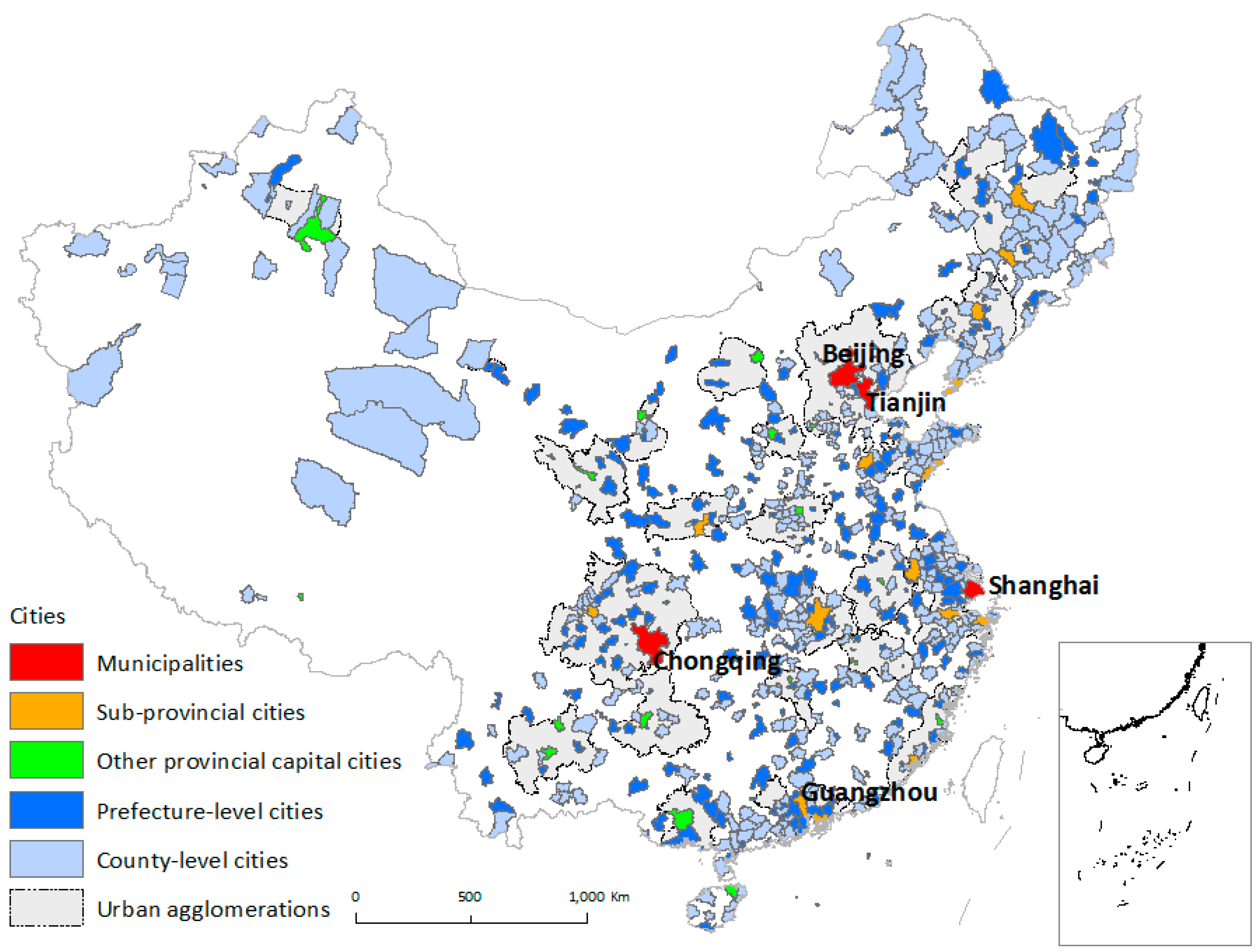
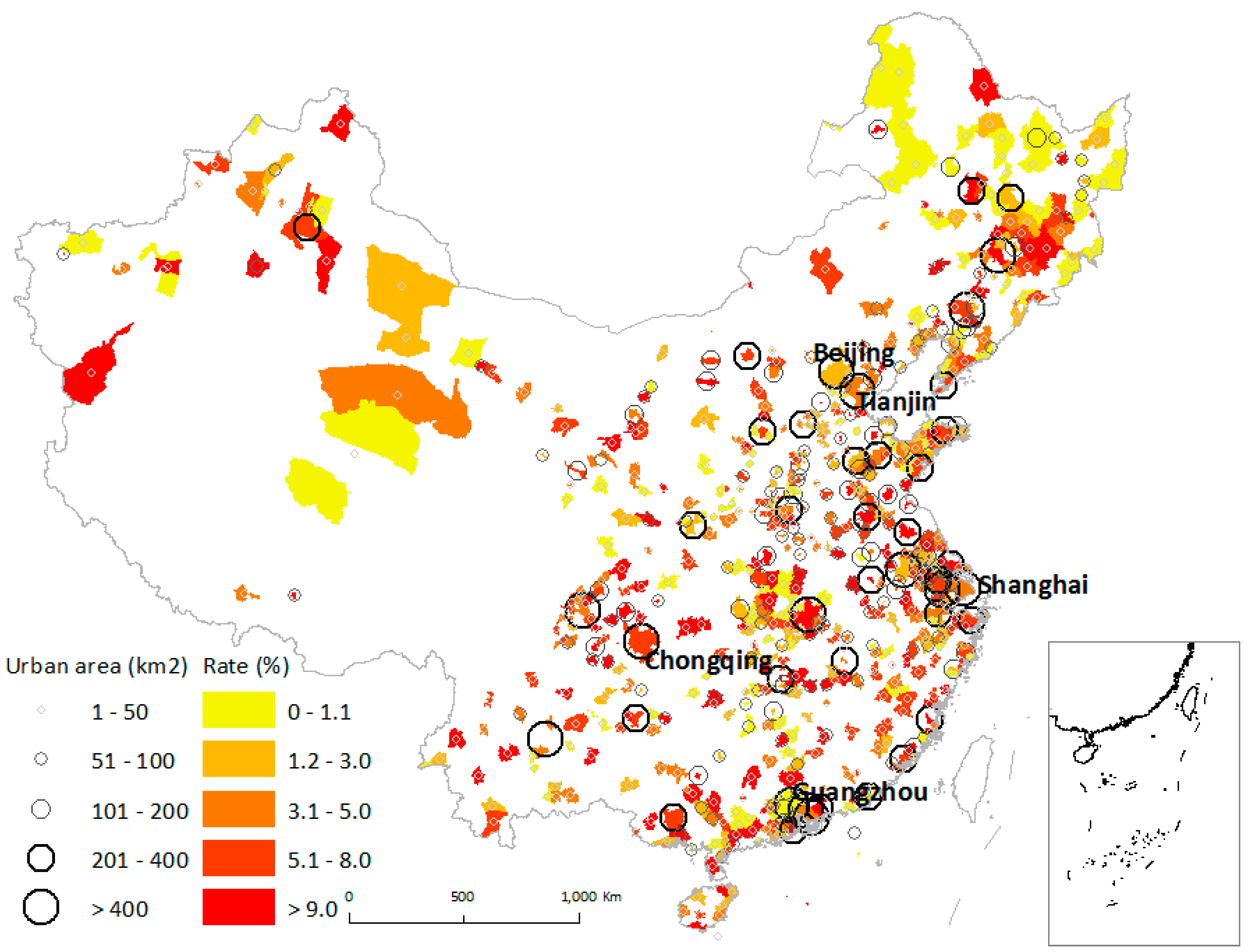
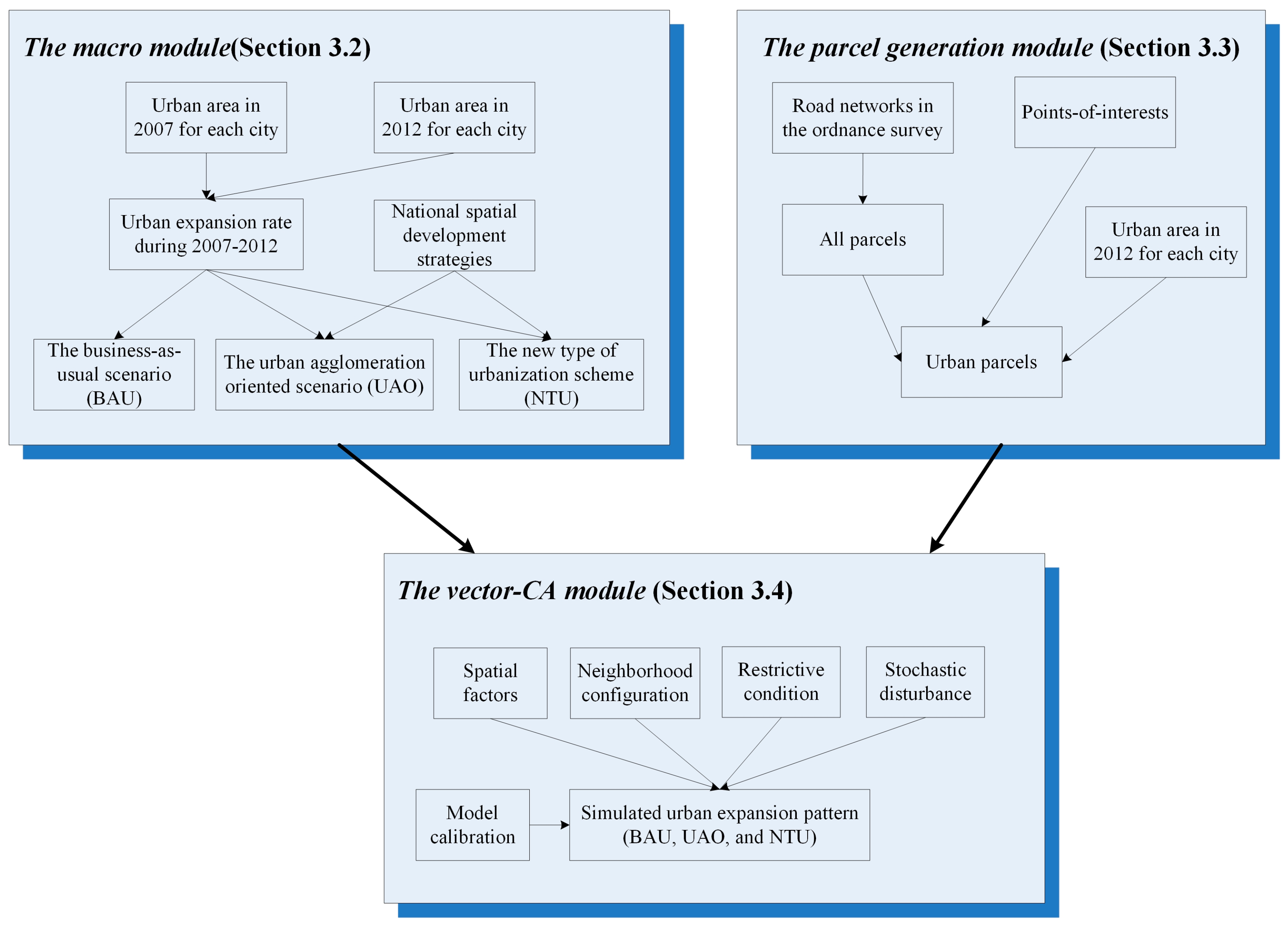
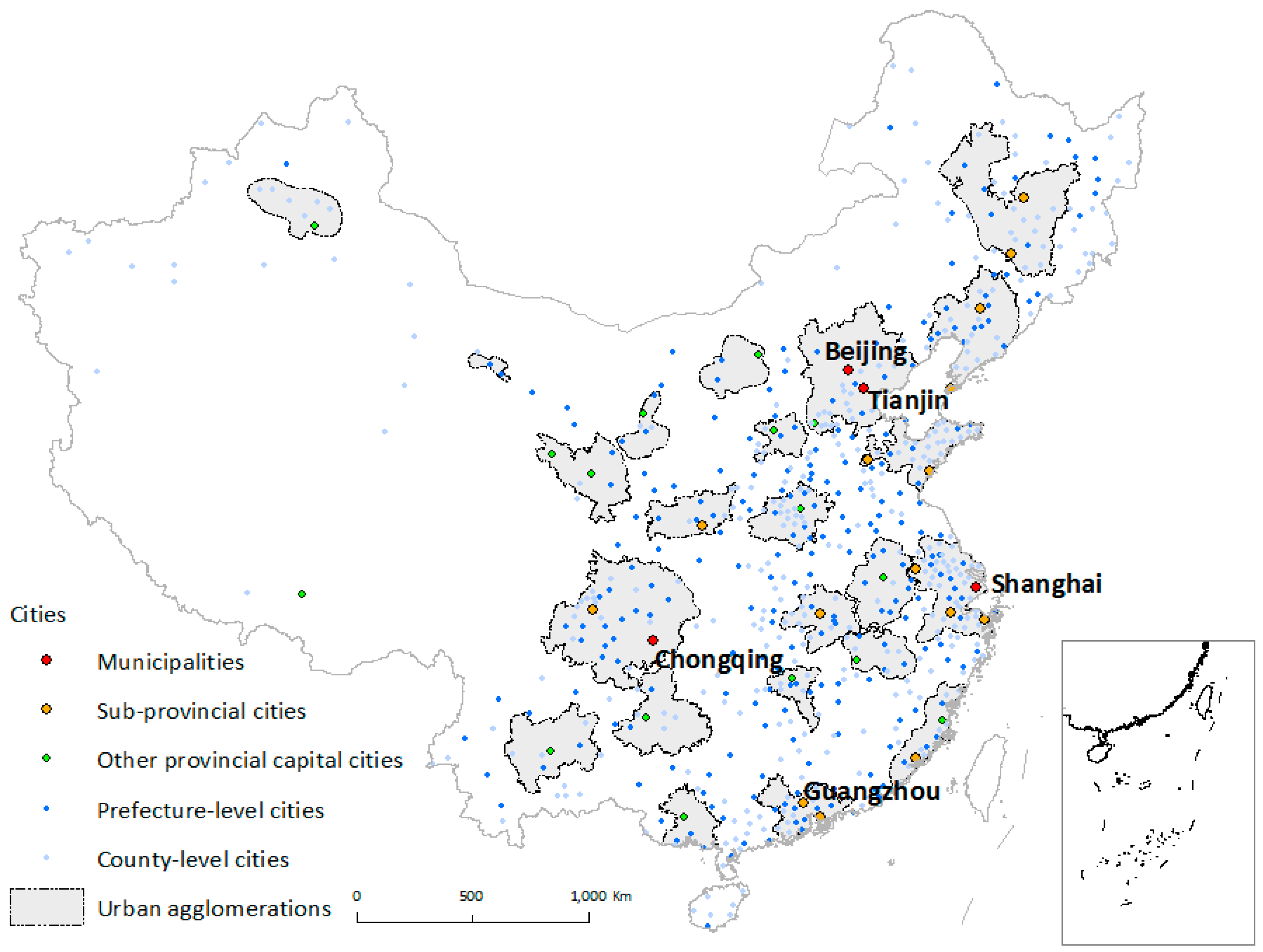
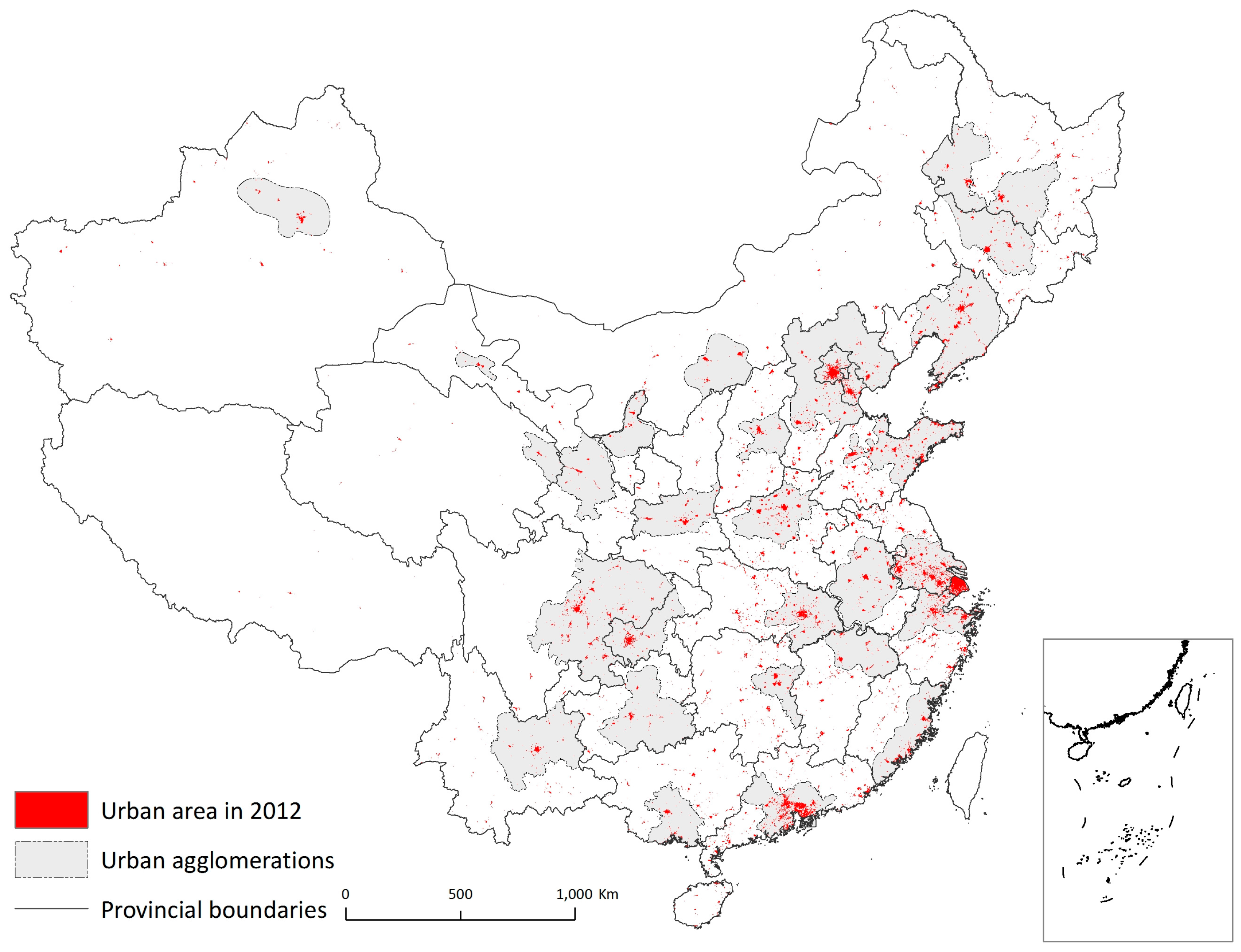
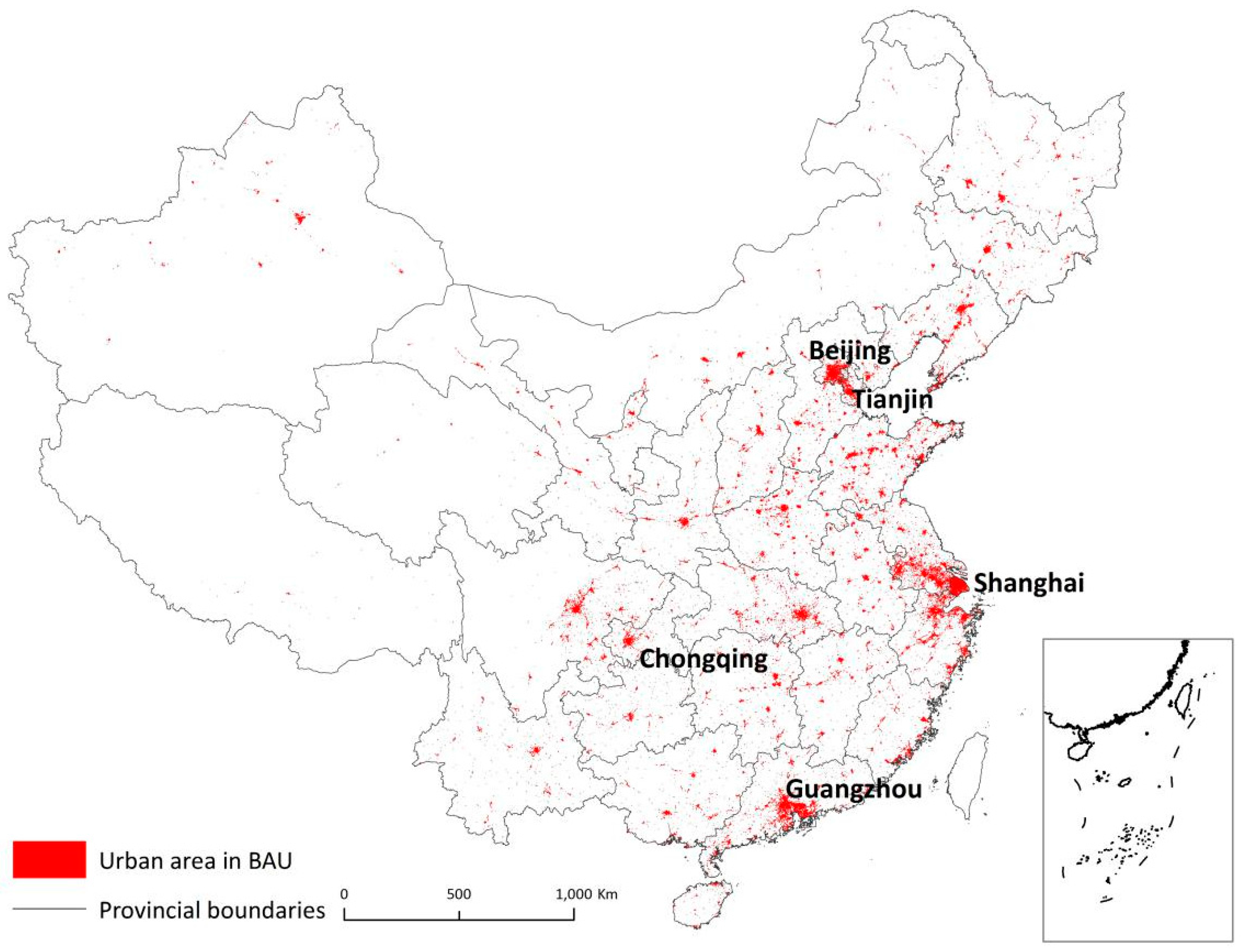


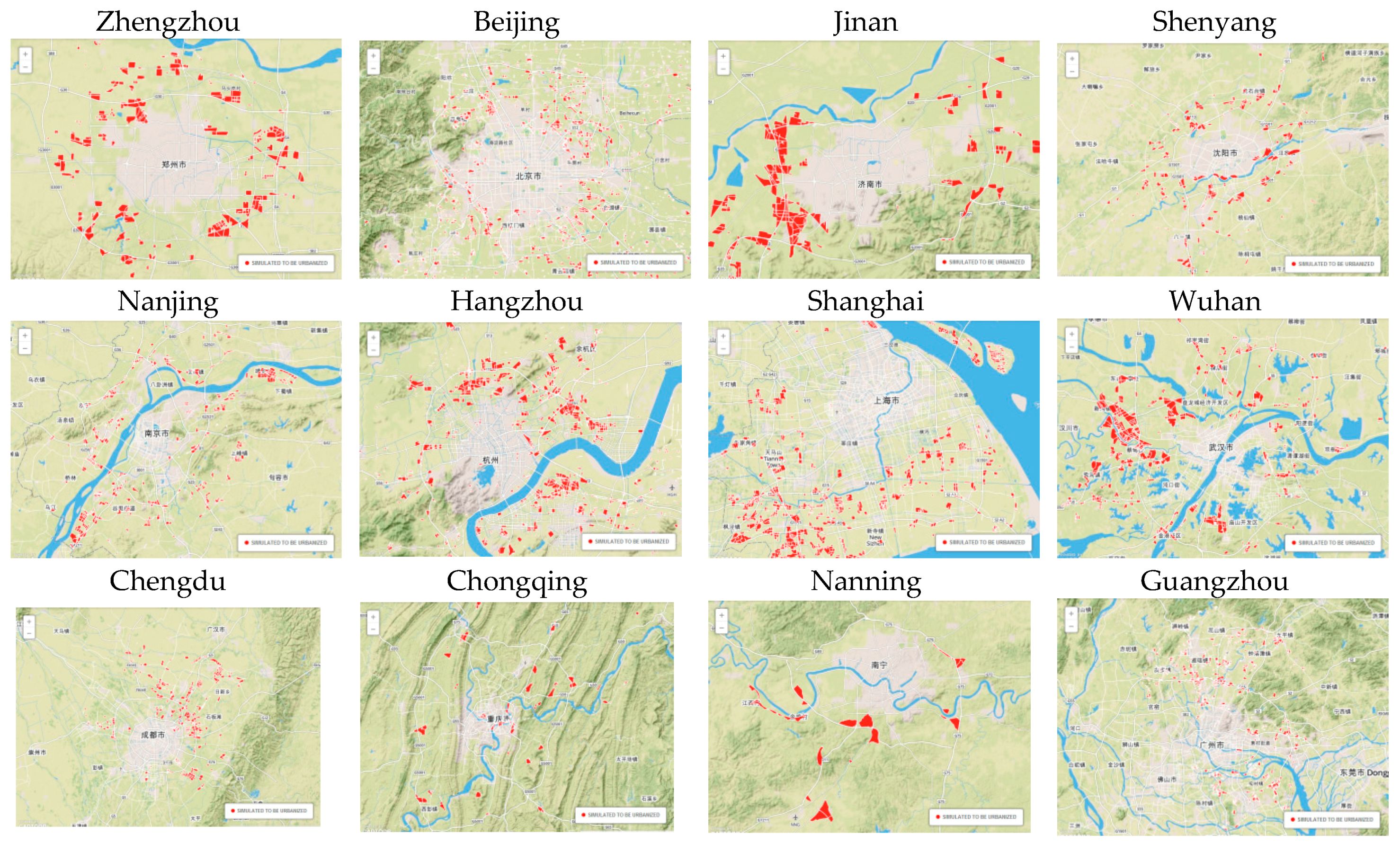

| Factor | Coefficient | S.E. | Wald | Sig. |
|---|---|---|---|---|
| SIZE_LN | −0.197 | 0.007 | 693.572 | 0.000 |
| COMPACT | 1.933 | 0.962 | 4.033 | 0.045 |
| CENTER | −0.101 | 0.002 | 1891.809 | 0.000 |
| DENSITY | 2.230 | 0.110 | 407.554 | 0.000 |
| Constant | 2.224 | 0.082 | 739.440 | 0.000 |
| Factor | Coefficient | S.E. | Wald | Sig. |
|---|---|---|---|---|
| l_tam | 10.402 | 0.378 | 756.566 | 0.000 |
| l_city | 2.684 | 0.175 | 234.110 | 0.000 |
| l_town | −2.016 | 0.220 | 83.652 | 0.000 |
| l_road | 7.826 | 0.836 | 87.592 | 0.000 |
| g_conf | 0.535 | 0.089 | 35.774 | 0.000 |
| Constant | −11.832 | 0.801 | 218.329 | 0.000 |
© 2017 by the authors. Licensee MDPI, Basel, Switzerland. This article is an open access article distributed under the terms and conditions of the Creative Commons Attribution (CC BY) license (http://creativecommons.org/licenses/by/4.0/).
Share and Cite
Long, Y.; Wu, K. Simulating Block-Level Urban Expansion for National Wide Cities. Sustainability 2017, 9, 879. https://doi.org/10.3390/su9060879
Long Y, Wu K. Simulating Block-Level Urban Expansion for National Wide Cities. Sustainability. 2017; 9(6):879. https://doi.org/10.3390/su9060879
Chicago/Turabian StyleLong, Ying, and Kang Wu. 2017. "Simulating Block-Level Urban Expansion for National Wide Cities" Sustainability 9, no. 6: 879. https://doi.org/10.3390/su9060879





